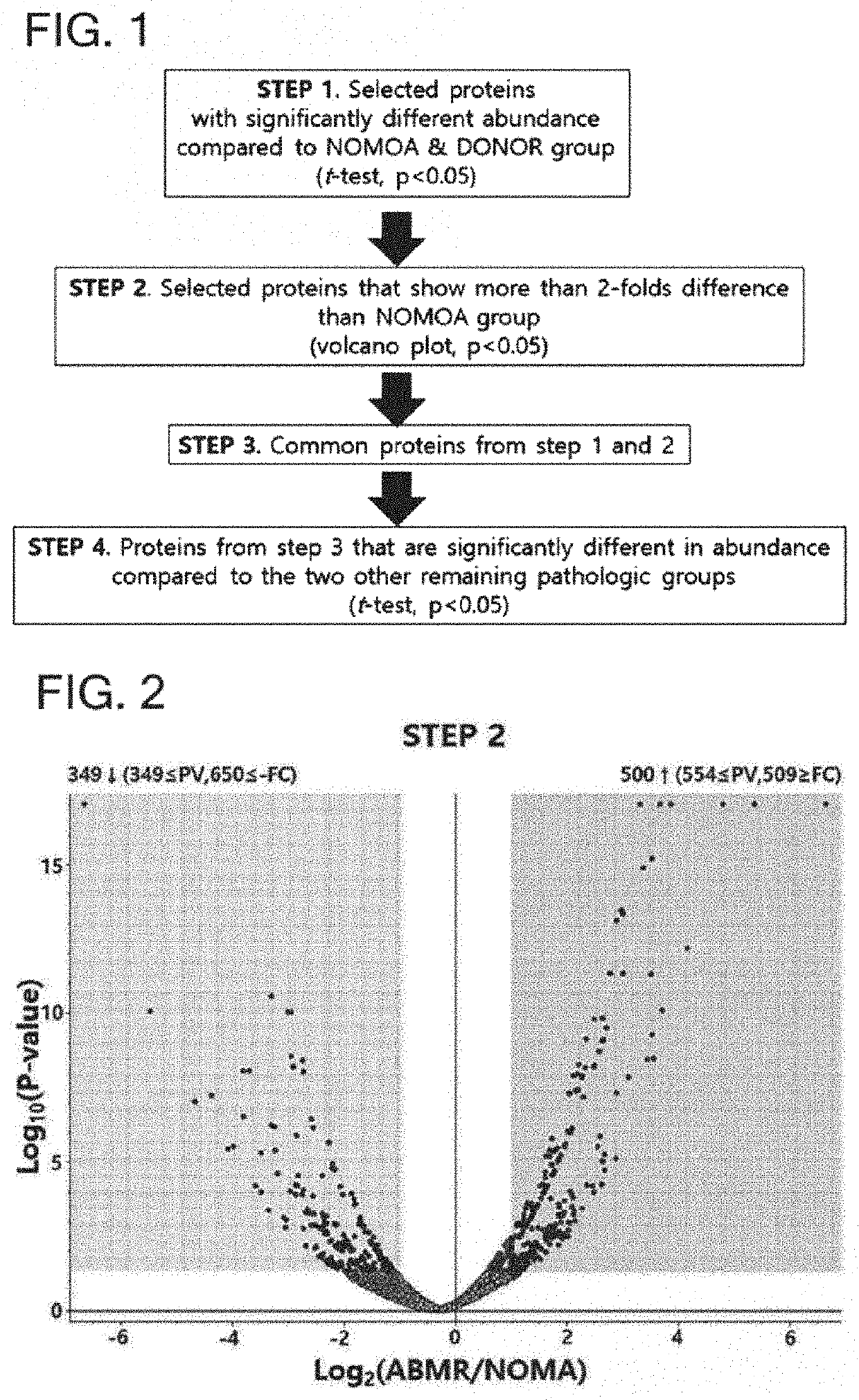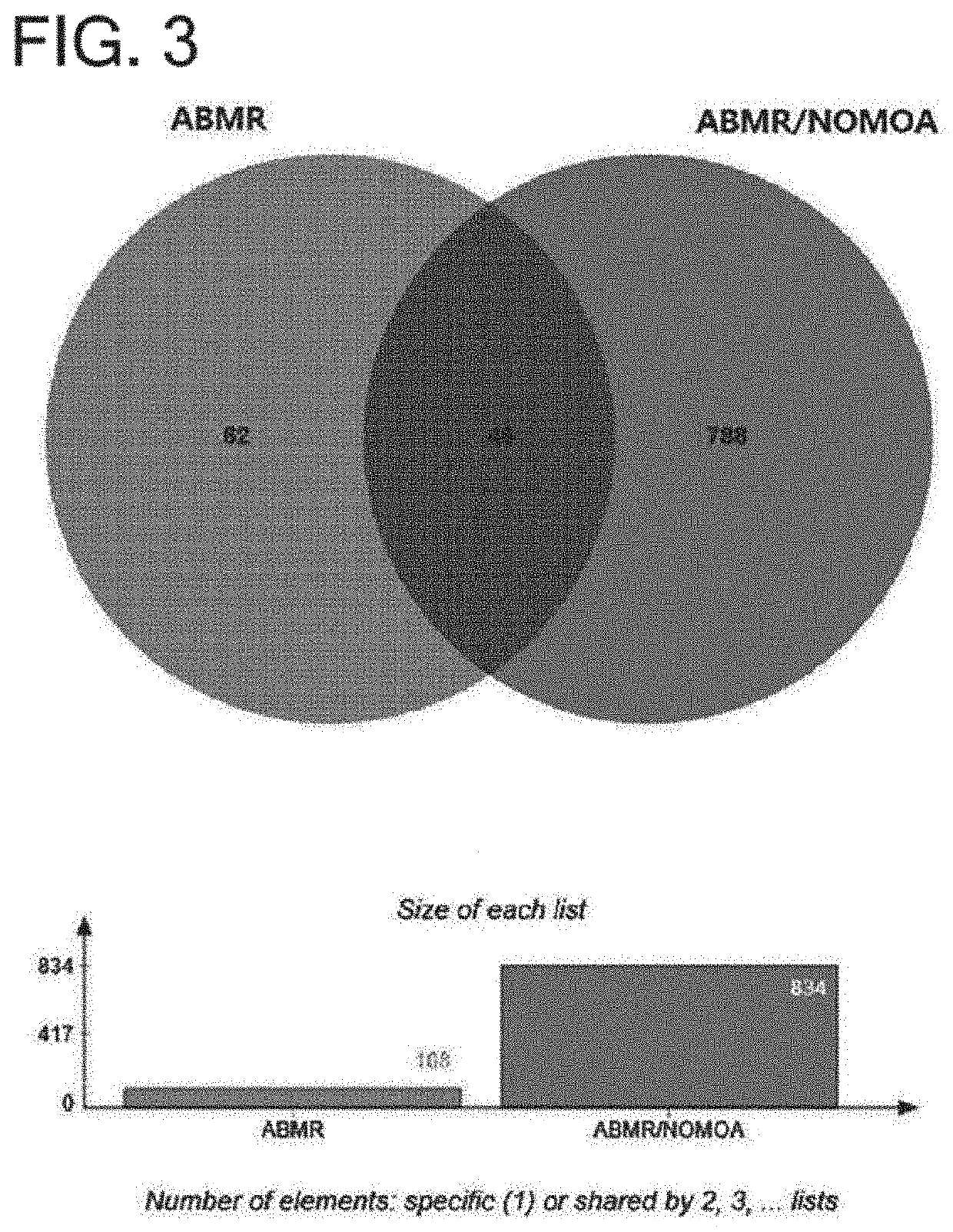Urinary exosome biomarker for diagnosing antibody-mediated rejection after kidney transplantation or predicting prognosis of patient after kidney transplantation
a technology of antibody-mediated rejection and urinary exosomes, which is applied in the field of urinary exosome biomarkers for diagnosing antibody-mediated rejection after kidney transplantation or predicting the prognosis of patient after kidney transplantation, can solve the problem of no studies to discover biomarkers, and achieve accurate and rapid diagnosis, accurately and quickly identify antibody-mediated rejection, and increase expression
- Summary
- Abstract
- Description
- Claims
- Application Information
AI Technical Summary
Benefits of technology
Problems solved by technology
Method used
Image
Examples
example 1
[0092]Selection of Patients and Preparation of Urine Samples
[0093]In order to discover biomarkers for diagnosing antibody-mediated rejection in kidney transplantation patients, mine samples were collected 2 to 3 hours before the biopsy from a total of 60 patients, including patients and donors who underwent an indication biopsy within 5 years of kidney transplantation. In addition, urine samples were collected from living kidney donors immediately before kidney donation surgery. The patients were classified into 5 groups according to the pathological diagnosis of biopsy: 12 antibody-mediated rejection (ABMR) groups, 8 T cell-mediated rejection (ABMR) groups, 5 BK virus nephropathy (BKVN) groups, 11 groups without major abnormalities (NOMOA) and 24 donor groups (DONOR). Urine from patients with mixed allopathic lesions was excluded. This study was conducted with the approval of the Medical Institution Evaluation Committee at Asan Medical Center, and written consent was obtained from ...
example 2
[0094]Processing of Urine Samples and Separation of Exosomes
[0095]By slightly modifying the methods of Pisitkim et al. (2004) and Alvarez et al. (2012), exosomes were separated from the prepared urine samples by step-wise ultracentrifugation. Specifically, 30 mL or more of urine samples was collected from each experiment participant, and 400 μL of a protease inhibitor mixture [50 μM 4-(2-animoethyl) benzenesulfonyl fluoride hydrochloride (AEBSF-HCl, Sigma Aldrich), 2 μM leupeptin-hemisulfate (Sigma Aldrich) and 3.3 mM sodium azide (Sigma Aldrich)] was added to each urine sample. In order to remove urinary sediments including whole cells, large membrane particles and other debris, the urine samples were centrifuged at 4,000 rpm and 4° C. for 15 minutes, and stored at −80° C. until the exosomes were extracted and used in the experiment.
[0096]Afterwards, the frozen urine samples were thawed by 15 mL each, vortexed for 1 minute and then centrifuged at 17,000×g for 15 minutes at room tem...
example 3
[0097]LC-MS Analysis and Protein Identification
[0098]Sample preparation for proteomic analysis was subjected to freeze drying, protein solubilization and digestion. The resulting peptide mixture was desalted, dried using C18 reverse phase chromatography, and then analyzed by high resolution mass spectrometry combined with nano-flow liquid chromatography.
[0099]Sequence database analysis and label free quantitation (LFQ) analysis were applied using Proteome Discoverer 2.2 (Thermo Fisher Scientific) to search for biomarker candidate substances for diagnosing or predicting kidney transplantation rejection. From this, 1,820 urine exosome proteins were identified. Gene ontology assignments, molecular function and Kegg pathway analysis were performed using the DAVID bioinformation database.
PUM
| Property | Measurement | Unit |
|---|---|---|
| concentration | aaaaa | aaaaa |
| drug resistance | aaaaa | aaaaa |
| length | aaaaa | aaaaa |
Abstract
Description
Claims
Application Information
 Login to View More
Login to View More - R&D
- Intellectual Property
- Life Sciences
- Materials
- Tech Scout
- Unparalleled Data Quality
- Higher Quality Content
- 60% Fewer Hallucinations
Browse by: Latest US Patents, China's latest patents, Technical Efficacy Thesaurus, Application Domain, Technology Topic, Popular Technical Reports.
© 2025 PatSnap. All rights reserved.Legal|Privacy policy|Modern Slavery Act Transparency Statement|Sitemap|About US| Contact US: help@patsnap.com



